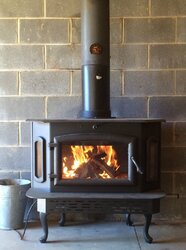Hello everyone, I am new to posting but not the site. I have been doing a lot of reading on this site which has increased my wood burning knowledge a great deal and I thank everyone for that.
My question is regarding my new high valley 2500 stove, I been getting a great great amount of heat out of it which we love but, we have not been able to get a long (>6 hr) burn time. It is set up with a metal flue pipe in the basement into a 8 inch round clay chimney!
What we do is get it nice and hot for about 30 mins with oak wood, engage the catalytic and watch the temp probe (condar cat probe) go up like it should to 1200-1400 deg, at the same time decrease to secondary air flow to the point that it is completely shut down. The flames do slow down and start to get somewhat lazy. At this point all air that could be shut off are closed down. The temp stays between 1100-1400 for the first 3 or so hrs and then slowly start to decrease.
My question would be, 1) is the stove burning right, or is that too hot? If it is burning too hot, how can I slow it down when I already closed all air ports that I can. Also if I could slow it down, would that increase my burn time?
Note this picture was taken prior to me getting the cat temp probe!!
My question is regarding my new high valley 2500 stove, I been getting a great great amount of heat out of it which we love but, we have not been able to get a long (>6 hr) burn time. It is set up with a metal flue pipe in the basement into a 8 inch round clay chimney!
What we do is get it nice and hot for about 30 mins with oak wood, engage the catalytic and watch the temp probe (condar cat probe) go up like it should to 1200-1400 deg, at the same time decrease to secondary air flow to the point that it is completely shut down. The flames do slow down and start to get somewhat lazy. At this point all air that could be shut off are closed down. The temp stays between 1100-1400 for the first 3 or so hrs and then slowly start to decrease.
My question would be, 1) is the stove burning right, or is that too hot? If it is burning too hot, how can I slow it down when I already closed all air ports that I can. Also if I could slow it down, would that increase my burn time?
Note this picture was taken prior to me getting the cat temp probe!!
Attachments
Last edited by a moderator:



 Now is there a way other than closing off the air supply into the stove to slow down the stove, will a flue damper help me in any way??
Now is there a way other than closing off the air supply into the stove to slow down the stove, will a flue damper help me in any way??